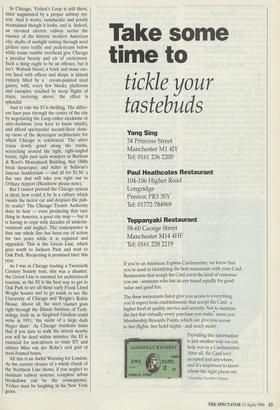Not motoring
Say yes to Yerkes
Gavin Stamp
Chicago must be the only city defined by its public transport. The city centre is not the City Centre, or the Merchant City, or the Old Town or even Downtown, but the Loop; and the Loop is formed by a rectangle of elevated railways running down the centre of streets laid out on the standard American gridiron. Originally the Downtown Union Loop was a loop of horse-drawn tram — streetcar — lines, but in the 1890s it was raised up on steel gantries and electrified, making it the cen- tre of a system with tentacles stretching north, west and south.
This was largely the achievement of one of the most extraordinary characters in transport history: Charles Tyson Yerkes. Having been imprisoned in Philadelphia for 'technical embezzlement', Yerkes moved his financial operation to the expanding city on Lake Michigan in 1882. He then began to buy up businesses, even- tually owning 432 miles of electric tramway, 47 miles of cable tramway and 40 miles of elevated electric railway using not wholly conventional means. To quote the Dictio- nary of American Biography, 'his methods were so devious that the empire of street- railway enterprises became known as the `Chicago traction tangle'.' It was a network of construction companies, operating com- panies and holding companies, of inter- locking directorships and friendly contracts, of financial manipulation and political corruption. . . '
By unifying and improving transport sys- tems, Yerkes could have been regarded as a public benefactor; instead, because of the methods he used and the poor quality of the service he provided, a huge crowd equipped with guns and nooses gathered outside City Hall in 1899 as politicians voted against granting Yerkes further con- cessions; he sold out and retreated to his Fifth Avenue mansion in New York. He then turned his attention to London and bought up the nascent tube lines, creating the Underground Electric Railways Com- pany of London.
Yerkes once announced that, 'The secret of success in my business is to buy up old junk, fix it up a little and unload it onto other fellows', and that, 'Straphangers pay the dividends'. He died before his tube lines were opened, but he was just the sort of entrepreneur to whom Mrs Thatcher would have given a peerage. In Chicago, Yerkes's Loop is still there, since augmented by a proper subway sys- tem. And it works, ramshackle and poorly maintained though it looks, and is. Indeed, an elevated electric railway seems the essence of the historic modern American city; shafts of sunlight cutting through steel girders onto traffic and pedestrians below while trains rumble overhead give Chicago a peculiar beauty and air of excitement. Such a thing ought to be an offence, but it isn't. Wabash Street, a brick and stone cav- ern lined with offices and shops, is almost entirely filled by a cream-painted steel gantry, with, every few blocks, platforms and canopies, reached by steep flights of stairs, teetering above; the effect is splendid.
And to ride the El is thrilling. The differ- ent lines pass through the centre of the city by negotiating the Loop either clockwise or anti-clockwise (you have to know which), and afford spectacular second-floor close- up views of the skyscraper architecture for which Chicago is celebrated. The silver trains slowly grind along the tracks, screeching around the tight, right-angled bends, right past such wonders as Burham & Root's Monadnock Building, that 1880s brick skyscraper, and Adler & Sullivan's famous Auditorium — and all for $1.50: a flat rate that will take you right out to O'Hare Airport (Heathrow please note).
But I cannot pretend the Chicago system is ideal; how could it be in a culture which vaunts the motor car and despises the pub- lic realm? The Chicago Transit Authority does its best — even producing that rare thing in America, a good city map — but it is having to cope with decades of underin- vestment and neglect. The consequence is that one whole line has been out of action for two years while it is repaired and upgraded. This is the Green Line, which goes south to Jackson Park and west to Oak Park. Reopening is promised later this year.
As I was in Chicago leading a Twentieth Century Society tour, this was a disaster: the Green Line is essential for architectural tourism, as the El is the best way to get to Oak Park to see all those early Frank Lloyd Wright houses and to go south to see the University of Chicago and Wright's Robie House. Above all, the steel viaduct goes right through the Illinois Institute of Tech- nology, built in, as Siegfried Giedion could write in 1951, 'the midst of a large dark Negro slum'. As Chicago residents insist that if you dare to walk the streets nearby you will be dead within minutes, the El is essential for non-drivers to visits ITT and admire Mies van der Rohe's arid grid of steel-framed boxes.
All this is an Awful Warning for London. As the current closure of a whole chunk of the Northern Line shows, if you neglect to maintain railway systems, complete urban breakdown can be the consequence. Yerkes must be laughing in• his New York grave.



































































 Previous page
Previous page